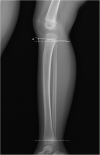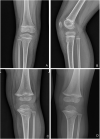Trampoline-related fractures of the proximal tibia in children
- PMID: 34496913
- PMCID: PMC8424931
- DOI: 10.1186/s13018-021-02707-9
Trampoline-related fractures of the proximal tibia in children
Abstract
Background: Trampoline-related fractures of the proximal tibial metaphysis are common in children and have been linked to subsequent valgus deformity of the tibia. The purpose of this study was to investigate the characteristics of trampoline-related proximal tibial fractures in young children.
Methods: We evaluated 40 patients with proximal tibial fracture after trampolining between 2013 and 2019. The median duration of follow-up was 18 months. Standing long leg radiographs were obtained at the last follow-up to evaluate angular deformity and limb length inequality in the patients. The measurements recorded include the lower limb length, mechanical lateral distal femoral angle (mLDFA), medial proximal tibial angle (MPTA), mechanical axis deviation (MAD), and anatomical tibio-femoral angle (aTFA). The anterior tilt angle (ATA) was measured using a lateral radiograph of the tibia.
Results: The median age at injury was 40.0 months. Using trampoline with a heavier person was the most common mechanism of injury. aTFA and MAD were found to be increased towards the valgus at the last follow-up in our patient; however, the increase was not statistically significant (p = 0.692 and p = 0.973, respectively). The anterior tilt angle was increased in the injured leg at the last follow-up. But the change was not statistically significant (p = 0.09).
Conclusions: Using trampoline with a heavier person carries the risk of trampoline-related proximal tibial fracture in young children. We did not find a significant change in limb alignment at a minimum of one year of follow-up.
Keywords: Children; Fracture; Proximal tibia; Trampoline.
© 2021. The Author(s).
Conflict of interest statement
Not applicable.
Figures


References
MeSH terms
LinkOut - more resources
Full Text Sources
Medical
Research Materials

